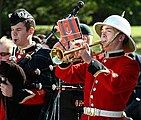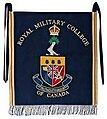
A pipe band is a musical ensemble consisting of pipers and drummers. The term pipes and drums, used by military pipe bands is also common.
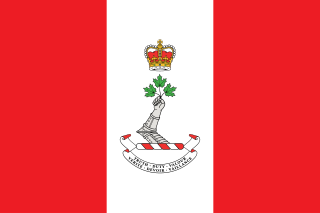
The Royal Military College of Canada, abbreviated in English as RMC and in French as CMR, is a military academy and, since 1959, a degree-granting university of the Canadian Armed Forces. It was established in 1874 and conducted its first classes on June 1, 1876. The Government of Ontario empowered RMC to confer degrees in the Social Sciences and Humanities, Science, and Engineering through The Royal Military College of Canada Degrees Act, 1959. Programs are offered at the undergraduate and graduate levels, both on campus as well as through the college's distance learning programme via the Division of Continuing Studies.
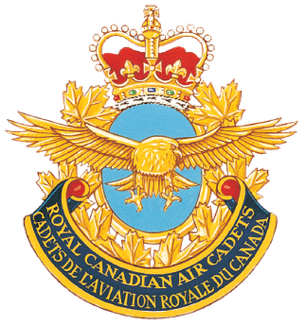
The Royal Canadian Air Cadets is a Canadian national youth program for young individuals aged 12 to 19. Under the authority of the National Defence Act, the program is administered by the Canadian Forces (CF) and funded through the Department of National Defence (DND). Additional support is provided by the civilian Air Cadet League of Canada (ACLC). Together with the Royal Canadian Sea Cadets and Royal Canadian Army Cadets, it forms the "largest federally funded youth program in the country". Cadets are not members of the military and are not obliged to join the Canadian Forces.

The RMC Paladins are the athletic teams that represent Royal Military College of Canada in Kingston, Ontario, Canada. Its facilities include the Kingston Military Community Sport Centre (KMCSC) with seating for 3737, the Navy Bay fields with seating for 800 and Constantine Arena with seating for 1500 and the Birchall Pavilion.

The pipe major is the leading musician of a pipe band, whether military or civilian. Like the appointment of drum major, the position is derived from British Army traditions. During the early twentieth century, the term sergeant piper was used instead. The pipe major is often assisted by a pipe sergeant, who has similar duties in the band and leads the band in the absence of the pipe major.

St. Andrew's College (SAC) is an independent boarding and day school founded in 1899 and located in Aurora, Ontario, Canada. It is a university-preparatory school for boys in grades 5 to 12, with a focus on academic achievement, athletics, and leadership development. It is accredited by the Canadian Educational Standards Institute and is affiliated with other associations, including CAIS, CASE, NAIS and the International Boys' Schools Coalition (IBSC). The school's coat of arms was registered with the Canadian Heraldic Authority on August 15, 2006.
Precision is the authorized march of Royal Military College of Canada. The RMC band performs Precision during parades and march pasts, as well as on Ex-Cadet Weekends.

St. George's Cathedral in Kingston, Ontario, Canada, is the cathedral church of the Anglican Diocese of Ontario.

The Regimental Pipes and Drums of The Calgary Highlanders is an authorized volunteer pipe band associated with The Calgary Highlanders of the Canadian Forces. For many years, the band was a bona fide, and separate, military unit unto itself, with a separate Unit Identification Code within the CF. Today, the band has been reduced to volunteer status but officially maintains an establishment of eight paid military musicians on its rolls. The band has had mixed success in competitions, but under the direction of Pipe Major Michael Giles had become successful in the Grade Three circuit in Alberta in the years leading up to the regimental centennial in 2010. The band published a recording to commemorate the 80th anniversary of the Regiment in 1990, titled Eighty Years of Glory and commemorated its centennial in 2010 by releasing a second CD entitled Onward.
The Regimental Band and Pipes was founded on The Citadel campus in Charleston, South Carolina in 1909 with late marine general, Harry K. Pickett, in command. The marching band makes up one of the twenty-one companies of the South Carolina Corps of Cadets. In 1991, the band participated in the Edinburgh Military Tattoo in Edinburgh, Scotland becoming the first military college selected for the honor. They returned in 2010 as the only unit from the United States to appear at the Silver Jubilee of the Tattoo and appeared again in 2015.

A drum major in the military is the individual leading a military band or a field unit. It is an appointment, not a military rank. Military drum majors utilize a ceremonial mace for giving commands while marching. Many drum majors, particularly American- or British-influenced ones, wear a sash that can carry embroidered badges of their home unit and battle honors; a pair of ceremonial drum sticks are often attached.

Canadian military bands are a group of personnel in the Canadian Armed Forces (CAF) that performs musical duties for military functions. Military bands form a part of the Music Branch of the CAF, composed of six full-time professional Regular Force bands, 15 Regular Force voluntary bands, and 53 part-time reserve force bands. Bands of the Music Branch are often badged with the unit or Canadian Forces base insignia that they support.

The Indian military bands consists of musicians from the Indian Army, Navy and Air Force. Indian military bands regularly participate in international festivals and take part in celebrations dedicated to various national events. These bands are permanent participants in the Delhi Republic Day parade on the Rajpath. Today, the Indian Armed Forces have more than 50 military brass bands and 400 pipe bands and corps of drums. A Tri-Services Band refers to a joint Indian Armed Forces military band that performs together as a unit. At the Spasskaya Tower Military Music Festival and Tattoo in Moscow, the band consisted of 7 officers and 55 musicians. The Military Music Wing of the Army Education Corps is the principal educational institution of the armed forces that provides instruction to musicians of all ranks. Instruction is also provided by the Military Music Training Center and the Indian Navy School of Music.
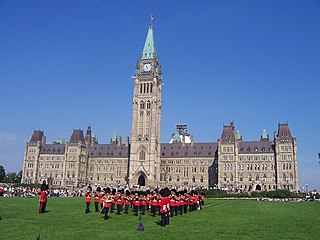
The Band of the Ceremonial Guard is an ad hoc military band that is attached to the Canadian Forces Ceremonial Guard in Ottawa. All members of the band are fully trained members of the Canadian Armed Forces (CAF) and consists of personnel principally from the two Foot Guards regiments and has even since 2007 been manned by a pan–Canadian Forces approach that is inclusive to musicians from the Royal Canadian Navy, Canadian Army and Royal Canadian Air Force. The band forms a separate company within the CG and rely on the Headquarters Company for administration and support personnel. In full composition, the band is active from April to August.
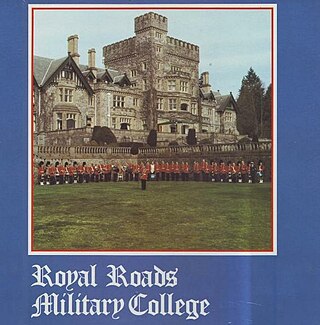
The Royal Roads Military College Band was the college military marching band for the Royal Roads Military College in Hatley Park, near Victoria, British Columbia, Canada. It was formed in 1975. The band was disbanded in 1995 following the closing of Royal Roads Military College.
The Band of the Royal Canadian Corps of Signals was a regimental military band in Canada based out of Canadian Forces Base Kingston in Ontario. It is a voluntary band, which means that its band members are not composed of full-time professional musicians. The band provided musical support for the community in the Kingston, Ontario metropolitan area as well as Ottawa–Gatineau.
The Loyal Edmonton Regiment Band (L EDMN R Band), a Canadian Army volunteer brass and reed band that serves as the de facto official military band of the Central and Northern Alberta area and the regimental band of The Loyal Edmonton Regiment (4th Battalion, Princess Patricia's Canadian Light Infantry) in Edmonton, Alberta. Operationally, it's part of the 41 Canadian Brigade Group. The band's force strength is currently at 22 personnel.
The 48th Highlanders of Canada Pipes and Drums is an authorized pipe band in the Canadian Forces and is currently located at Moss Park Armoury in Toronto, Ontario. The current pipe major is Master Warrant Officer Iain Lang, who is concurrently the official piper to the Lieutenant Governor of Ontario.

The military bands of the United Kingdom are musical units that serve for protocol and ceremonial duties as part of the British Armed Forces. They have been the basis and inspiration for many military bands in the former British Empire and the larger Commonwealth of Nations as well as musical organizations in other countries. Military musical units with British influence include United States military bands, the Japan Ground Self-Defense Force Music Corps and the Military Band of Athens. British military bands are controlled by the military music departments of the three services that compose the armed forces. These include the Royal Marines Band Service, the Royal Corps of Army Music, and the Royal Air Force Music Services. British style brass bands and carnival bands were then and are currently inspired by the British Armed Forces and its brass bands, especially of the Army's regular and reserve formations, as they follow a similar format as it relates to brass and percussion instruments.



